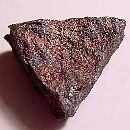|
|
||||||||||||||||
|
||||||||||||||||
|
||||||
|
|
|
|
Germanite
|
|
| | |
| Discovered in 1922; IMA status: Valid (pre-IMA; Grandfathered) | ||
|
| ||
|
Chemistry |
|
|
| |
|
Cu26Fe2+4Ge4S32 | |
|
|
Copper Iron Germanium Sulfide |
|
Molecular Weight: |
3,192.14 gm |
|
Composition: |
Iron |
7.00 % |
Fe |
|
|
|
|
Copper |
51.76 % |
Cu |
|
|
|
|
Germanium |
9.10 % |
Ge |
|
|
|
|
Sulfur |
32.14 % |
S |
|
|
|
|
|
100.00 % |
|
|
|
|
|
|
||||
|
Classification |
|
|
| |
|
Sulfides | |
|
2/C.10-20 | |
|
|
2 : SULFIDES and SULFOSALTS (sulfides, selenides, tellurides; arsenides,
antimonides, bismuthides; sulfarsenites, sulfantimonites,
sulfbismuthites, etc.) |
|
Related to: |
n/a |
|
Varieties: |
None |
|
Synonyms: |
ICSD 64787, PDF 36-395 |
|
|
|
|
Crystal Data |
|
|
|
|
|
Cubic crystals, rarely to 3 cm; commonly massive, intergrown with Reniérite. |
|
|
None |
|
|
|
|
|
Physical Properties |
|
|
|
|
|
None |
|
|
Irregular/Uneven |
|
|
Brittle |
|
|
4.0 |
|
|
4.46 - 4.59 (g/cm3) |
|
|
None |
|
|
Not Radioactive |
|
|
|
|
|
Optical Properties |
|
|
|
|
|
Pale grayish pink, reddish gray, tarnishes to a dull brown; in polished section, pinkish gray. |
|
|
Opaque |
|
|
Metallic, dull |
|
|
Reflectivity: |
Isotropic. R: (400) 21.9, (420) 21.5, (440) 21.1, (460) 20.6, (480) 20.0, (500) 19.6, (520) 19.7, (540) 20.2, (560) 21.0, (580) 21.9, (600) 22.8, (620) 23.8, (640) 24.7, (660) 25.5, (680) 26.2, (700) 26.8 |
|
RL Color: |
Pinkish gray |
|
|
|
|
Occurances |
|
|
|
|
|
Geological Setting: |
In primary Cu–Pb–Zn ores in a dolostone-hosted hydrothermal polymetallic ore deposit (Tsumeb, Namibia). |
|
Common Associations: |
Reniérite, Pyrite, Tennantite, Enargite, Galena, Sphalerite, Digenite, Bornite, Chalcopyrite. |
|
Common Impurities: |
Ga, Zn, Mo, As, V |
|
Type Locality: |
Tsumeb Mine (Tsumcorp Mine), Tsumeb, Otjikoto Region (Oshikoto), Namibia |
|
Year Discovered: |
1922 |
|
View mineral photos: | |
|
|
|
|
More Information |
|
|
|
|
|
| |
|
|
|
|
Distribution:
From Tsumeb, Namibia (the type locality). At M’Passa, 150 km west of Brazzaville, Congo
Republic. From Kipushi, 28 km southwest of Lubumbashi, Katanga Province, Congo (Shaba
Province, Zaire). In the USA, at the Inexco #1 mine, Jamestown, Boulder County, Colorado; and
in the Ruby Creek deposit, Brooks Range, near Bornite, Alaska. In Cuba, from Pinar del Rio
Province. In Bulgaria, at the Radka deposit, Pazardzhik. From Dastakert, Armenia. At Bor,
Serbia. From the Bancairoun mine, Alpes-Maritimes, France. At Weisloch, ??, Germany. In
Russia, from Vaygach, Arkhangel’sk, and in the Noril’sk region, western Siberia; at the Vaigach
and Sibai deposits, Ural Mountains. In the Shakanai mine, Akita Prefecture, Japan.
|
|
|
We
have not photographed our Germanite gems yet. Please
check back soon. |
